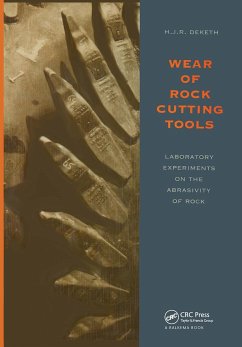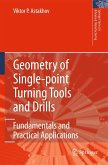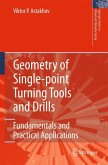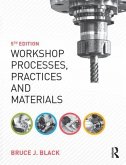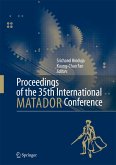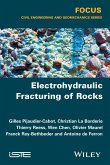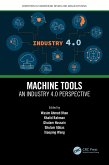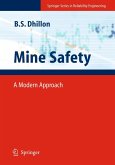- Gebundenes Buch
- Merkliste
- Auf die Merkliste
- Bewerten Bewerten
- Teilen
- Produkt teilen
- Produkterinnerung
- Produkterinnerung
This text provides an insight into the wear processes which take place during the cutting of rock with steel cutting tools. Rock cutting experiments in different rock types leading to a new approach to the estimation of rock cutting tool wear are ...
Andere Kunden interessierten sich auch für
![Geometry of Single-Point Turning Tools and Drills Geometry of Single-Point Turning Tools and Drills]() Viktor P. AstakhovGeometry of Single-Point Turning Tools and Drills235,99 €
Viktor P. AstakhovGeometry of Single-Point Turning Tools and Drills235,99 €![Geometry of Single-point Turning Tools and Drills Geometry of Single-point Turning Tools and Drills]() Viktor P. AstakhovGeometry of Single-point Turning Tools and Drills164,99 €
Viktor P. AstakhovGeometry of Single-point Turning Tools and Drills164,99 €![Workshop Processes, Practices and Materials Workshop Processes, Practices and Materials]() Bruce BlackWorkshop Processes, Practices and Materials181,99 €
Bruce BlackWorkshop Processes, Practices and Materials181,99 €![Proceedings of the 35th International Matador Conference Proceedings of the 35th International Matador Conference]() Proceedings of the 35th International Matador Conference150,99 €
Proceedings of the 35th International Matador Conference150,99 €![Electrohydraulic Fracturing of Rocks Electrohydraulic Fracturing of Rocks]() Christian La BorderieElectrohydraulic Fracturing of Rocks170,99 €
Christian La BorderieElectrohydraulic Fracturing of Rocks170,99 €![Machine Tools Machine Tools]() Machine Tools161,99 €
Machine Tools161,99 €![Mine Safety Mine Safety]() Balbir S. DhillonMine Safety170,99 €
Balbir S. DhillonMine Safety170,99 €-
-
-
This text provides an insight into the wear processes which take place during the cutting of rock with steel cutting tools. Rock cutting experiments in different rock types leading to a new approach to the estimation of rock cutting tool wear are ...
Hinweis: Dieser Artikel kann nur an eine deutsche Lieferadresse ausgeliefert werden.
Hinweis: Dieser Artikel kann nur an eine deutsche Lieferadresse ausgeliefert werden.
Produktdetails
- Produktdetails
- Verlag: CRC Press
- Seitenzahl: 154
- Erscheinungstermin: 1. Januar 1995
- Englisch
- Abmessung: 254mm x 178mm x 11mm
- Gewicht: 490g
- ISBN-13: 9789054106203
- ISBN-10: 9054106204
- Artikelnr.: 54608433
- Herstellerkennzeichnung
- Libri GmbH
- Europaallee 1
- 36244 Bad Hersfeld
- gpsr@libri.de
- Verlag: CRC Press
- Seitenzahl: 154
- Erscheinungstermin: 1. Januar 1995
- Englisch
- Abmessung: 254mm x 178mm x 11mm
- Gewicht: 490g
- ISBN-13: 9789054106203
- ISBN-10: 9054106204
- Artikelnr.: 54608433
- Herstellerkennzeichnung
- Libri GmbH
- Europaallee 1
- 36244 Bad Hersfeld
- gpsr@libri.de
Technical University Delft, Section Engineering Geology Delft.
Preface
1 Introduction
2 Rock cutting theories
3 Possible wear mechanisms at the wear
flat of rock cutting tools
3.1 Introduction
3.2 Wear type classifications
3.2.1 The motion category classification
3.2.2 The wear mechanism classification
3.3 Wear mechanisms relevant to rock cutting tools
3.3.1 Abrasive wear
3.3.2 Adhesive wear
3.3.3 Sliding wear
3.3.4 Total wear due to sliding motion contact
4 Wear mode hypothesis
4.1 Introduction
4.2 Cutting forces
4.2.1 Influences of rock material properties on cutting forces
4.2.2 Influences of rock mass properties on cutting forces
4.2.3 The influence of some operating condition factors on cutting forces
4.3 Rock relief strength
4.3.1 The influence of rock material strengin properties on relief strength
4.3.2 The influence of the geometry of the relief on relief strength
4.3.3 Hardness of the mineral grains
4.4 Wear mode prevalence
5 Rock cutting tests to study wear
5.1 Introduction
5.2 The scraping test
6 Rock properties with respect to wear
6.1 Introduction
6.1.1 Rock property based rock cutting wear index values
6.1.2 Some considerations on the non
intrinsic rock property parameters
7 Experiments
7.1 Introduction
7.2 Scraping test experiments
8 Chisels used in the experiments
8.1 Introduction
8.2 Chisel material
8.3 Chisel shape
8.4 Thermocouple
9 Properties of rock types used in the experiments
9.1 Rock material properties
9.1.1 Interpretation of the measured and derived rock properties
9.2 Rock sample preparation
10 Test results on artificial rock (mortar)
10.1 Repeatability and the effect of groove spacing
10.1.1 Effect of spacing of the grooves, sawn into the rock disc
10.1.2 Repeatability of the experiments, with respect to the amount of wear
10.2 Scraping test experiments on mortar at constant cutting velocity
10.2.1 Experiments on mortar composition I
10.2.2 Results of experiments on three mortars of different strength
10.2.3 Results of experiments on four mortars of different grain size
10.2.4 Results of experiments on three mortars of different volume percentage of abrasive grains
10.2.5 Results of experiments on two mortars of different shape of the quartz grains
10.2.6 Results of experiments on mortars of different mineral content
10.3 Specific wear equations based upon scraping test experiments on morta
10.4 Scraping test experiments on mortar with varying cutting velocity
10.4.1 Experiments on mortar composition 8
10.4.2 Experiments on different mortars
10.5 Comments on the experiments on artificial rock (mortar)
11 Test results on natural rock types
11.1 Introduction
11.2 Experimental results
11.2.1 Experiments on sandstones
11.2.2 Experiments on limestones
11.2.3 Correlation of test results obtained in experiments on artificial or natural rock
11.3 Comments on the experiments on natural rock
12 Relation of the scraping tests with rock cutting projects in practice
12.1 Description of the T
850 rock cutting trencher
12.2 Calculation of the feed of a single bit of the T
850 rock cutting trencher
12.3 The specific wear in the schnarrtanne granite and the oberdorfer sandstone, predicted on the basis of results from the scraping test experiments
12.4 Comparison of the field results with the experimental results
13 Conclusions
14 Closing remarks and recommendations
Nomenclature
List of abbreviations and symbols
References
Appendix I: Comparison of porosity values determined by different methods
Appendix II: Petrographic descripitions
Appendix III: Momentary cutting forces in tests on Elb
sandstone D.
1 Introduction
2 Rock cutting theories
3 Possible wear mechanisms at the wear
flat of rock cutting tools
3.1 Introduction
3.2 Wear type classifications
3.2.1 The motion category classification
3.2.2 The wear mechanism classification
3.3 Wear mechanisms relevant to rock cutting tools
3.3.1 Abrasive wear
3.3.2 Adhesive wear
3.3.3 Sliding wear
3.3.4 Total wear due to sliding motion contact
4 Wear mode hypothesis
4.1 Introduction
4.2 Cutting forces
4.2.1 Influences of rock material properties on cutting forces
4.2.2 Influences of rock mass properties on cutting forces
4.2.3 The influence of some operating condition factors on cutting forces
4.3 Rock relief strength
4.3.1 The influence of rock material strengin properties on relief strength
4.3.2 The influence of the geometry of the relief on relief strength
4.3.3 Hardness of the mineral grains
4.4 Wear mode prevalence
5 Rock cutting tests to study wear
5.1 Introduction
5.2 The scraping test
6 Rock properties with respect to wear
6.1 Introduction
6.1.1 Rock property based rock cutting wear index values
6.1.2 Some considerations on the non
intrinsic rock property parameters
7 Experiments
7.1 Introduction
7.2 Scraping test experiments
8 Chisels used in the experiments
8.1 Introduction
8.2 Chisel material
8.3 Chisel shape
8.4 Thermocouple
9 Properties of rock types used in the experiments
9.1 Rock material properties
9.1.1 Interpretation of the measured and derived rock properties
9.2 Rock sample preparation
10 Test results on artificial rock (mortar)
10.1 Repeatability and the effect of groove spacing
10.1.1 Effect of spacing of the grooves, sawn into the rock disc
10.1.2 Repeatability of the experiments, with respect to the amount of wear
10.2 Scraping test experiments on mortar at constant cutting velocity
10.2.1 Experiments on mortar composition I
10.2.2 Results of experiments on three mortars of different strength
10.2.3 Results of experiments on four mortars of different grain size
10.2.4 Results of experiments on three mortars of different volume percentage of abrasive grains
10.2.5 Results of experiments on two mortars of different shape of the quartz grains
10.2.6 Results of experiments on mortars of different mineral content
10.3 Specific wear equations based upon scraping test experiments on morta
10.4 Scraping test experiments on mortar with varying cutting velocity
10.4.1 Experiments on mortar composition 8
10.4.2 Experiments on different mortars
10.5 Comments on the experiments on artificial rock (mortar)
11 Test results on natural rock types
11.1 Introduction
11.2 Experimental results
11.2.1 Experiments on sandstones
11.2.2 Experiments on limestones
11.2.3 Correlation of test results obtained in experiments on artificial or natural rock
11.3 Comments on the experiments on natural rock
12 Relation of the scraping tests with rock cutting projects in practice
12.1 Description of the T
850 rock cutting trencher
12.2 Calculation of the feed of a single bit of the T
850 rock cutting trencher
12.3 The specific wear in the schnarrtanne granite and the oberdorfer sandstone, predicted on the basis of results from the scraping test experiments
12.4 Comparison of the field results with the experimental results
13 Conclusions
14 Closing remarks and recommendations
Nomenclature
List of abbreviations and symbols
References
Appendix I: Comparison of porosity values determined by different methods
Appendix II: Petrographic descripitions
Appendix III: Momentary cutting forces in tests on Elb
sandstone D.
Preface
1 Introduction
2 Rock cutting theories
3 Possible wear mechanisms at the wear
flat of rock cutting tools
3.1 Introduction
3.2 Wear type classifications
3.2.1 The motion category classification
3.2.2 The wear mechanism classification
3.3 Wear mechanisms relevant to rock cutting tools
3.3.1 Abrasive wear
3.3.2 Adhesive wear
3.3.3 Sliding wear
3.3.4 Total wear due to sliding motion contact
4 Wear mode hypothesis
4.1 Introduction
4.2 Cutting forces
4.2.1 Influences of rock material properties on cutting forces
4.2.2 Influences of rock mass properties on cutting forces
4.2.3 The influence of some operating condition factors on cutting forces
4.3 Rock relief strength
4.3.1 The influence of rock material strengin properties on relief strength
4.3.2 The influence of the geometry of the relief on relief strength
4.3.3 Hardness of the mineral grains
4.4 Wear mode prevalence
5 Rock cutting tests to study wear
5.1 Introduction
5.2 The scraping test
6 Rock properties with respect to wear
6.1 Introduction
6.1.1 Rock property based rock cutting wear index values
6.1.2 Some considerations on the non
intrinsic rock property parameters
7 Experiments
7.1 Introduction
7.2 Scraping test experiments
8 Chisels used in the experiments
8.1 Introduction
8.2 Chisel material
8.3 Chisel shape
8.4 Thermocouple
9 Properties of rock types used in the experiments
9.1 Rock material properties
9.1.1 Interpretation of the measured and derived rock properties
9.2 Rock sample preparation
10 Test results on artificial rock (mortar)
10.1 Repeatability and the effect of groove spacing
10.1.1 Effect of spacing of the grooves, sawn into the rock disc
10.1.2 Repeatability of the experiments, with respect to the amount of wear
10.2 Scraping test experiments on mortar at constant cutting velocity
10.2.1 Experiments on mortar composition I
10.2.2 Results of experiments on three mortars of different strength
10.2.3 Results of experiments on four mortars of different grain size
10.2.4 Results of experiments on three mortars of different volume percentage of abrasive grains
10.2.5 Results of experiments on two mortars of different shape of the quartz grains
10.2.6 Results of experiments on mortars of different mineral content
10.3 Specific wear equations based upon scraping test experiments on morta
10.4 Scraping test experiments on mortar with varying cutting velocity
10.4.1 Experiments on mortar composition 8
10.4.2 Experiments on different mortars
10.5 Comments on the experiments on artificial rock (mortar)
11 Test results on natural rock types
11.1 Introduction
11.2 Experimental results
11.2.1 Experiments on sandstones
11.2.2 Experiments on limestones
11.2.3 Correlation of test results obtained in experiments on artificial or natural rock
11.3 Comments on the experiments on natural rock
12 Relation of the scraping tests with rock cutting projects in practice
12.1 Description of the T
850 rock cutting trencher
12.2 Calculation of the feed of a single bit of the T
850 rock cutting trencher
12.3 The specific wear in the schnarrtanne granite and the oberdorfer sandstone, predicted on the basis of results from the scraping test experiments
12.4 Comparison of the field results with the experimental results
13 Conclusions
14 Closing remarks and recommendations
Nomenclature
List of abbreviations and symbols
References
Appendix I: Comparison of porosity values determined by different methods
Appendix II: Petrographic descripitions
Appendix III: Momentary cutting forces in tests on Elb
sandstone D.
1 Introduction
2 Rock cutting theories
3 Possible wear mechanisms at the wear
flat of rock cutting tools
3.1 Introduction
3.2 Wear type classifications
3.2.1 The motion category classification
3.2.2 The wear mechanism classification
3.3 Wear mechanisms relevant to rock cutting tools
3.3.1 Abrasive wear
3.3.2 Adhesive wear
3.3.3 Sliding wear
3.3.4 Total wear due to sliding motion contact
4 Wear mode hypothesis
4.1 Introduction
4.2 Cutting forces
4.2.1 Influences of rock material properties on cutting forces
4.2.2 Influences of rock mass properties on cutting forces
4.2.3 The influence of some operating condition factors on cutting forces
4.3 Rock relief strength
4.3.1 The influence of rock material strengin properties on relief strength
4.3.2 The influence of the geometry of the relief on relief strength
4.3.3 Hardness of the mineral grains
4.4 Wear mode prevalence
5 Rock cutting tests to study wear
5.1 Introduction
5.2 The scraping test
6 Rock properties with respect to wear
6.1 Introduction
6.1.1 Rock property based rock cutting wear index values
6.1.2 Some considerations on the non
intrinsic rock property parameters
7 Experiments
7.1 Introduction
7.2 Scraping test experiments
8 Chisels used in the experiments
8.1 Introduction
8.2 Chisel material
8.3 Chisel shape
8.4 Thermocouple
9 Properties of rock types used in the experiments
9.1 Rock material properties
9.1.1 Interpretation of the measured and derived rock properties
9.2 Rock sample preparation
10 Test results on artificial rock (mortar)
10.1 Repeatability and the effect of groove spacing
10.1.1 Effect of spacing of the grooves, sawn into the rock disc
10.1.2 Repeatability of the experiments, with respect to the amount of wear
10.2 Scraping test experiments on mortar at constant cutting velocity
10.2.1 Experiments on mortar composition I
10.2.2 Results of experiments on three mortars of different strength
10.2.3 Results of experiments on four mortars of different grain size
10.2.4 Results of experiments on three mortars of different volume percentage of abrasive grains
10.2.5 Results of experiments on two mortars of different shape of the quartz grains
10.2.6 Results of experiments on mortars of different mineral content
10.3 Specific wear equations based upon scraping test experiments on morta
10.4 Scraping test experiments on mortar with varying cutting velocity
10.4.1 Experiments on mortar composition 8
10.4.2 Experiments on different mortars
10.5 Comments on the experiments on artificial rock (mortar)
11 Test results on natural rock types
11.1 Introduction
11.2 Experimental results
11.2.1 Experiments on sandstones
11.2.2 Experiments on limestones
11.2.3 Correlation of test results obtained in experiments on artificial or natural rock
11.3 Comments on the experiments on natural rock
12 Relation of the scraping tests with rock cutting projects in practice
12.1 Description of the T
850 rock cutting trencher
12.2 Calculation of the feed of a single bit of the T
850 rock cutting trencher
12.3 The specific wear in the schnarrtanne granite and the oberdorfer sandstone, predicted on the basis of results from the scraping test experiments
12.4 Comparison of the field results with the experimental results
13 Conclusions
14 Closing remarks and recommendations
Nomenclature
List of abbreviations and symbols
References
Appendix I: Comparison of porosity values determined by different methods
Appendix II: Petrographic descripitions
Appendix III: Momentary cutting forces in tests on Elb
sandstone D.

